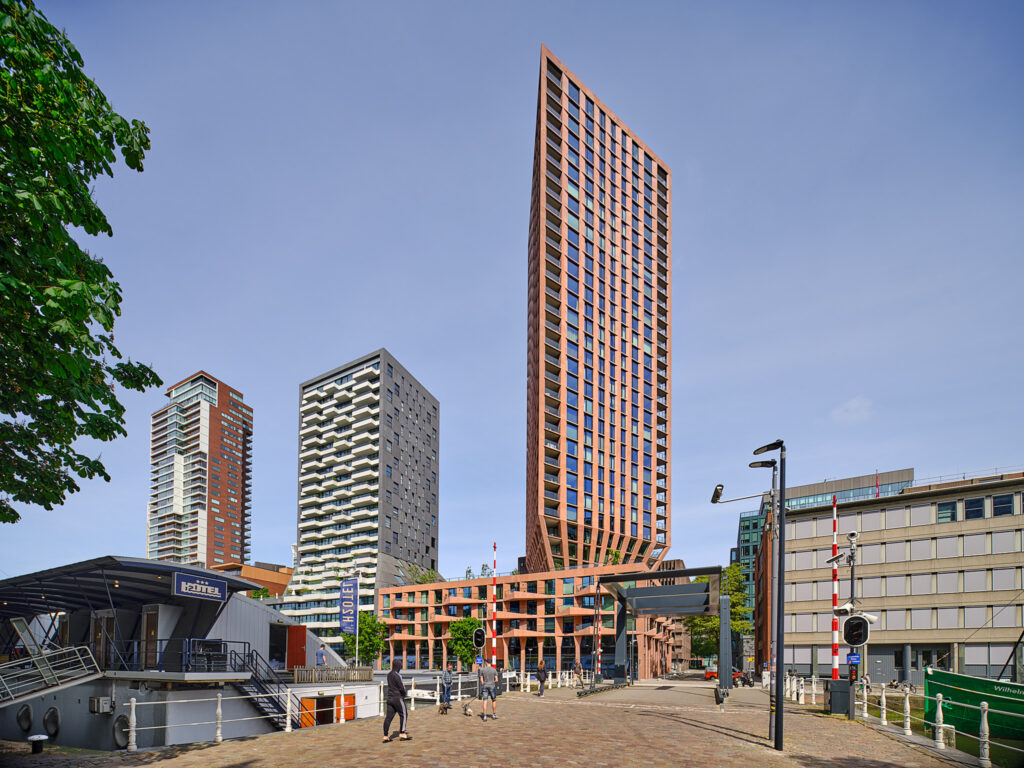THE ROBIN AMSTERDAM
The characteristic high-rise design ´De Robin´ has a prominent position within the OMA masterplan for the Bijlmerbajes Central District.
From 1978 to 2016, the Bijlmerbajes was one of the most famous prison complexes in the Netherlands, consisting of six iconic towers connected by a central connecting corridor. In 2019, OMA, LOLA Landscape Architects and FABRICations created the master plan for this area with a rich history and the image of a forbidden island. The new Bajeskwartier will be lively city quarter with approximately 1,350 homes, international allure and an important role for design, art and sustainable interventions.
Location
Amsterdam, the Netherlands
Client
Bajes Kwartier Ontwikkeling C.V.
Year
2018 – ongoing
Status
Under construction (expected delivery 2024)
Size
16.200m²
Category
Residential / Mix use - High rise
Collaborators
BAM A&E (structural engineer), Techniplan (installations), DGMR (acoustics, daylight, fire safety), OMA (master plan), CompaNanny (daycare), LOLA Landscape Architects (landscape architect), Beeldenfabriek (visualization)
Photography:
Hans Wilschut
Egbert de Boer
Team
Dirk Peters, Robbert Peters, Hans van Pelt, Reinier van Vliet, Jelena Nikolic, Tjeerd van de Sandt, Michele Cherubini, Mariachiara Mondini



Our building occupies a prominent position in this plan — in the Central District, at the square where the two main axes of the area intersect. With The Robin, the original volume of one of the prison towers is rebuilt and extended with three interlocking, lower volumes. These 'boxes' are lifted 4.5 meters from the ground, creating space for a light, inviting plinth with public functions at ground level, such as a service center and a day care. A strong connection with the urban context is created by opening up the plinth on all sides.


Dirk Peters, founder
The atrium hidden in the heart of the building presents itself as an unexpected impressive and unexpected feature. The six-storey high open space is the building's vibrant heart and offers space for a multitude of possible functions, such as exhibitions, extensive works of art and public events for the neighbourhood. A unique experience for both residents and visitors.

The residential program comprises 129 apartments and appeals to a wide range of target groups. The bright, spacious homes range from compact, functional studios to sprawling lofts. Private loggias and balconies, and collective green roof terraces on top of each of the three boxes offer the building's residents a variety of high-quality outdoor spaces.


The dimensions of the tower follow the structure of the original tower. The low-rise refers in height to the adjacent buildings and gives the tower a broader base and an all-sided appearance. The building expresses a clear dialogue between old and new, between the massive and the light. Whereas the gold-coloured, open grid façade gives the three low-rise volumes human dimensions, the concrete façade of the tower has a more closed appearance that refers to the original tower building.

Like the Bajeskwartier area, our building is designed in a circular way. Part of an original prison wall will be given a new place in the design and a large part of the raw materials from the demolition of the old tower buildings will be reused in the construction. PV panels will be installed on both the roof of the tower and the highest block. In addition, The Robin will be fitted with nature-inclusive additions such as nesting boxes for birds and bats, green roofs, and insect shelters.
On the site of the original, anonymous prison tower, a dynamic building is created in which urban living quality and healthy, green living conditions come together. Barcode Architects' design provides the Bajeskwartier with a building with a strong identity and a powerful reference to the cultural history of the Bijlmerbajes.





